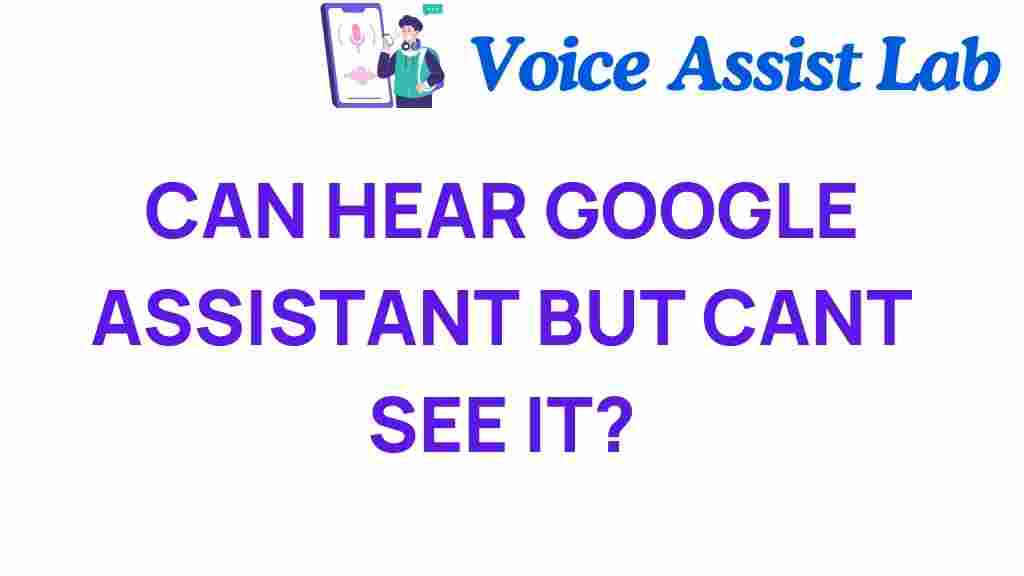Can You Hear the Google Assistant? Unlocking the Mystery of Voice Technology
In the ever-evolving world of technology, the emergence of voice technology has revolutionized how we interact with our devices. At the forefront of this innovation is the Google Assistant, a powerful digital assistant that has become an integral part of many smart homes. This article delves into the nuances of voice technology, exploring its capabilities, the user experience it offers, and how it integrates seamlessly with smart devices. We will also provide technology insights and troubleshooting tips for maximizing your interaction with these audio interfaces.
Understanding Voice Technology
Voice technology refers to the systems and applications that allow users to interact with devices through spoken commands. It encompasses various elements, including:
- Voice Recognition: The ability of a device to understand and interpret spoken language.
- Natural Language Processing: The technology that enables the assistant to comprehend and respond to user queries.
- Machine Learning: Algorithms that improve the system’s ability to recognize voice commands over time.
The integration of these technologies results in a user-friendly audio interface that enhances the overall user experience. With advancements in voice technology, the Google Assistant can perform a wide array of tasks, from managing smart devices to providing information about the weather.
How Google Assistant Works
The Google Assistant utilizes an intricate system of algorithms and data processing to function effectively. Here’s a step-by-step breakdown of how it operates:
- Activation: Users typically activate Google Assistant by saying “Hey Google” or “Ok Google.” This wake word is crucial as it signals the assistant to listen for commands.
- Voice Capture: Once activated, the microphone captures the user’s voice. Modern smart devices come equipped with high-quality microphones that can pick up commands even from a distance.
- Voice Recognition: The captured audio is then processed using advanced voice recognition technology to convert speech into text.
- Processing the Command: The text is analyzed using natural language processing to understand the user’s intent. The Google Assistant accesses vast databases and algorithms to find the best response.
- Response: Finally, the assistant delivers a spoken response or executes the requested action, such as adjusting a smart thermostat or playing music.
Benefits of Using Google Assistant in Smart Homes
Integrating Google Assistant into your smart home offers numerous advantages:
- Hands-Free Control: Control your devices without lifting a finger. Just ask, and the assistant responds.
- Convenience: Manage multiple smart devices from one central interface, enhancing the overall user experience.
- Customization: Set routines and personalize commands to fit your lifestyle.
- Information Access: Instantly retrieve information, including news, weather, and traffic updates.
Popular Smart Devices Compatible with Google Assistant
Google Assistant can seamlessly integrate with a variety of smart devices, making it an excellent choice for building a smart home ecosystem. Some popular devices include:
- Smart Speakers: Google Nest Audio, Google Home.
- Smart Displays: Google Nest Hub, Lenovo Smart Display.
- Smart Lights: Philips Hue, LIFX.
- Smart Thermostats: Nest Learning Thermostat, ecobee.
- Smart Cameras: Google Nest Cam, Arlo.
Improving Your User Experience with Google Assistant
To enhance your interaction with the Google Assistant, consider the following tips:
- Clear Commands: Speak clearly and use simple language to improve voice recognition accuracy.
- Use Specific Phrases: Instead of vague requests, be specific about what you want the assistant to do.
- Regular Updates: Keep your devices updated to ensure you have the latest features and improvements.
- Explore Features: Take the time to explore different commands and features available with Google Assistant.
Troubleshooting Common Issues
While using the Google Assistant, you may encounter some challenges. Here are common issues and solutions:
1. Google Assistant Not Responding
If the assistant fails to respond, try the following:
- Ensure the device is powered on and connected to the internet.
- Check if the microphone is muted or obstructed.
- Restart your device to resolve temporary glitches.
2. Poor Voice Recognition
If the assistant struggles to understand commands:
- Speak clearly and at a moderate pace.
- Minimize background noise to improve voice capture.
- Adjust the assistant’s language settings if necessary.
3. Connectivity Issues
If your devices aren’t responding:
- Check your Wi-Fi connection and ensure all devices are on the same network.
- Reboot your router if you’re experiencing network issues.
- Verify that each smart device is properly set up and connected to the Google Assistant.
Future of Voice Technology
The future of voice technology appears promising, with advancements in voice recognition and natural language processing leading the way. Here are some technology insights on what to expect:
- Enhanced Personalization: Future updates may allow Google Assistant to learn user preferences better, resulting in a more tailored user experience.
- Broader Integration: Expect increased compatibility with more devices and platforms, making smart homes even smarter.
- Improved Security: Voice authentication may become more prevalent, adding an extra layer of security to smart devices.
- Multi-Modal Interfaces: The integration of voice technology with other interfaces (like touch and gesture) may create a more seamless interaction experience.
Conclusion
In conclusion, the Google Assistant is a pivotal element of modern voice technology, transforming how we interact with our smart devices and enhancing our daily lives. By understanding how to effectively utilize this digital assistant, you can unlock countless possibilities in your smart home environment. As technology continues to evolve, staying informed will ensure you make the most out of your audio interface and improve your overall user experience. For more insights on voice technology, check out this external resource, and for further reading, visit our blog.
This article is in the category Innovations and created by VoiceAssistLab Team
